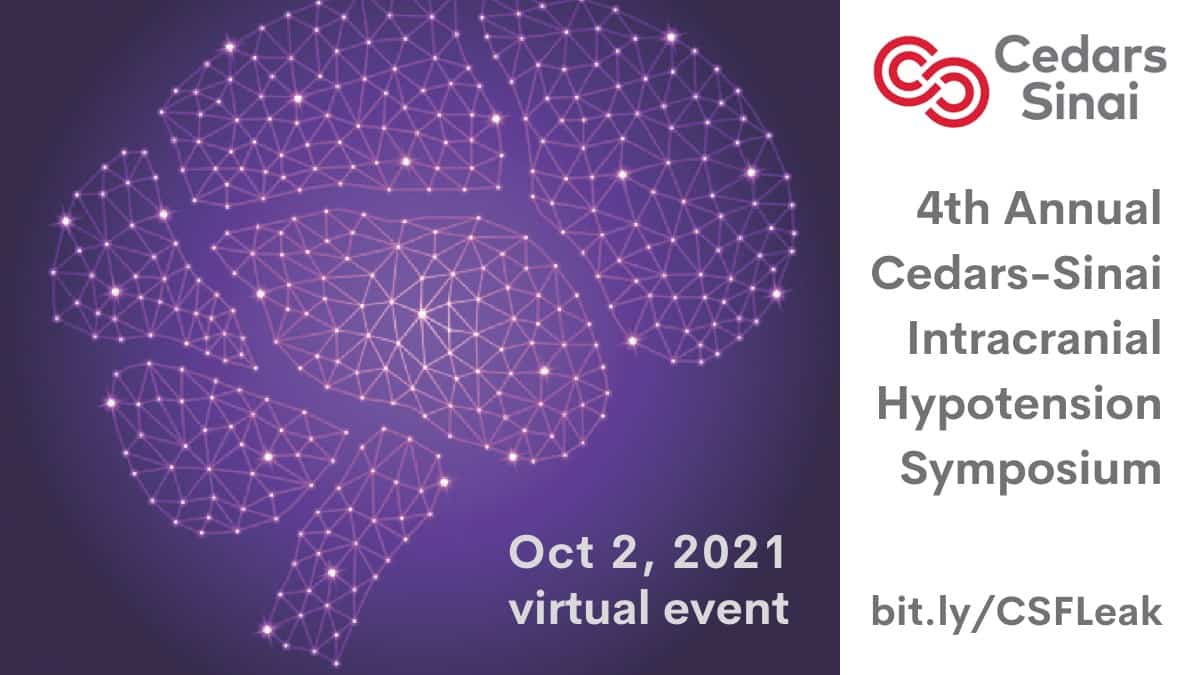Each month we send out an email newsletter to our subscribers. Below is our September 2021 newsletter. Click here to see past newsletters and subscribe!
The 4th Annual Cedars-Sinai Intracranial Hypotension Symposium is just one month away!

The Fourth Annual Cedars-Sinai Intracranial Hypotension Symposium is almost here—and this year it’s all online! Join experts and specialists on October 2, 2021, for a day of presentations and discussion about intracranial hypotension and spinal CSF leak, sponsored by a generous grant from the Spinal CSF Leak Foundation. Though the content is designed for health professionals, we welcome the attendance of patients, caregivers, and other laypersons. This year’s conference is all virtual, and patients and caregivers can register to livestream the day’s events for just $30.
Patient Stories
All this month, we’ve been revisiting stories of people affected by spinal CSF leak who share a common misdiagnosis, a common cause, and a common experience.
What do these three women have in common? CSF-venous fistula.

Kathy’s only symptom was pain when she coughed. Patty had several ear surgeries before it became clear that her leak was spinal, and not skull-based. And Alice suffered head pain after a sinus infection, but ultimately discovered there was nothing wrong with her head. All three had a spinal CSF leak due to CSF-venous fistula, which occurs when there is an an abnormal channel between the space where cerebrospinal fluid is and a vein outside the dura mater. You may find more information about CSF-venous fistula in our collection of 2021 Publication Abstracts.
What do these three people have in common? Misdiagnosis of migraine.

Alex suffered for almost four years before learning his diagnosis was spinal CSF leak, due to a dural tear caused by a bone spur. Aiza was treated for migraine for five years before she was correctly diagnosed with and successfully treated for spinal CSF leak. Casey had lived with migraine for a decade, so he knew his unusual head pain was not a migraine, but he still was given migraine treatment before his diagnosis of spinal CSF leak was finally made. Migraine is the most common misdiagnosis among patients with spontaneous intracranial hypotension (SIH), but an important hallmark of SIH is that migraine treatments are almost entirely ineffective.You may find more information about this and other common misdiagnoses here, in our article, “Let’s Make Misdiagnosis the Exception.”
As always, your support makes it all possible!
Your donations fund awareness efforts, like the patient stories shared above; education for both laypersons and health professionals, including the annual symposium; and research to reduce the suffering of people affected by intracranial hypotension or spinal CSF leak, such as the projects we have funded here.
With your help, we are making a difference in the lives of individuals affected by spinal CSF leak.
Thank you!
Text LEAK to 509-779-8100 to donate, or visit
https://spinalcsfleak.org/donate/
Spinal CSF Leak Foundation is fully registered and compliant in all states requiring registration, plus the District of Columbia. For more information, please see our charitable solicitation registration page.
